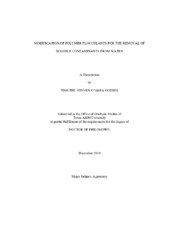| dc.contributor.advisor | McInnes, Kevin | |
| dc.creator | Goebel, Timothy Steven O'Gara | |
| dc.date.accessioned | 2012-02-14T22:18:57Z | |
| dc.date.accessioned | 2012-02-16T16:13:56Z | |
| dc.date.available | 2012-02-14T22:18:57Z | |
| dc.date.available | 2012-02-16T16:13:56Z | |
| dc.date.created | 2010-12 | |
| dc.date.issued | 2012-02-14 | |
| dc.date.submitted | December 2010 | |
| dc.identifier.uri | https://hdl.handle.net/1969.1/ETD-TAMU-2010-12-8948 | |
| dc.description.abstract | Contaminants in aqueous environments exist in phases that are sorbed to suspended or colloidal material and that are dissolved in solution. Polymer flocculants can be used to remove suspended or colloidal material along with sorbed contaminants, but they remove little of the dissolved contaminants. In the study presented here, development of polymers to sorb contaminants from aqueous solution during the flocculation process was investigated. Atrazine and phosphate (H₂PO₄ ̄) were chosen as test contaminants. For a given test contaminant, multiple copies of a functional group that interacted with that contaminant were inserted into the polymer backbone of a polyacrylamide flocculant. The functional groups inserted into the polymer structure acted as a trap for the dissolved contaminant. The traps were a cyclic secondary amine that interacted with atrazine, and a thiourea that interacted with phosphate. Modified flocculants with different configurations and densities of trapping groups were made and evaluated for removal of the test contaminants from aqueous suspensions. The suspensions consisted of bentonite or kaolinite in water with a known concentration of a test contaminant. The atrazine source was labeled with ¹⁴C and concentrations were measured using a scintillation counter. The source of phosphate used was NaH₂PO₄ and ion chromatography was used to measure the aqueous concentrations of phosphate. In general, the modified polymer flocculants containing trapping groups removed significantly more atrazine and phosphate from suspension compared to the control polymer flocculants ([alpha] =0.05). While the amount of modified polymers needed to achieve significant removal of the test contaminant were higher than the Environmental Protection Agency limit for concentration of polyacrylamide flocculants in water, it was possible to enhance the polymers sorbtion and removal of contaminants from solution during the flocculation process. | en |
| dc.format.mimetype | application/pdf | |
| dc.language.iso | en_US | |
| dc.subject | Polymer Flocculants | en |
| dc.subject | Contaminants, Phosphate, thiourea, atrazine piperazine | en |
| dc.title | Modification of Polymer Flocculants for the Removal of Soluble Contaminants from Water | en |
| dc.type | Thesis | en |
| thesis.degree.department | Soil and Crop Sciences | en |
| thesis.degree.discipline | Agronomy | en |
| thesis.degree.grantor | Texas A&M University | en |
| thesis.degree.name | Doctor of Philosophy | en |
| thesis.degree.level | Doctoral | en |
| dc.contributor.committeeMember | Senseman, Scott | |
| dc.contributor.committeeMember | Zuberer, David | |
| dc.contributor.committeeMember | Feagley, Sam | |
| dc.type.genre | thesis | en |
| dc.type.material | text | en |


